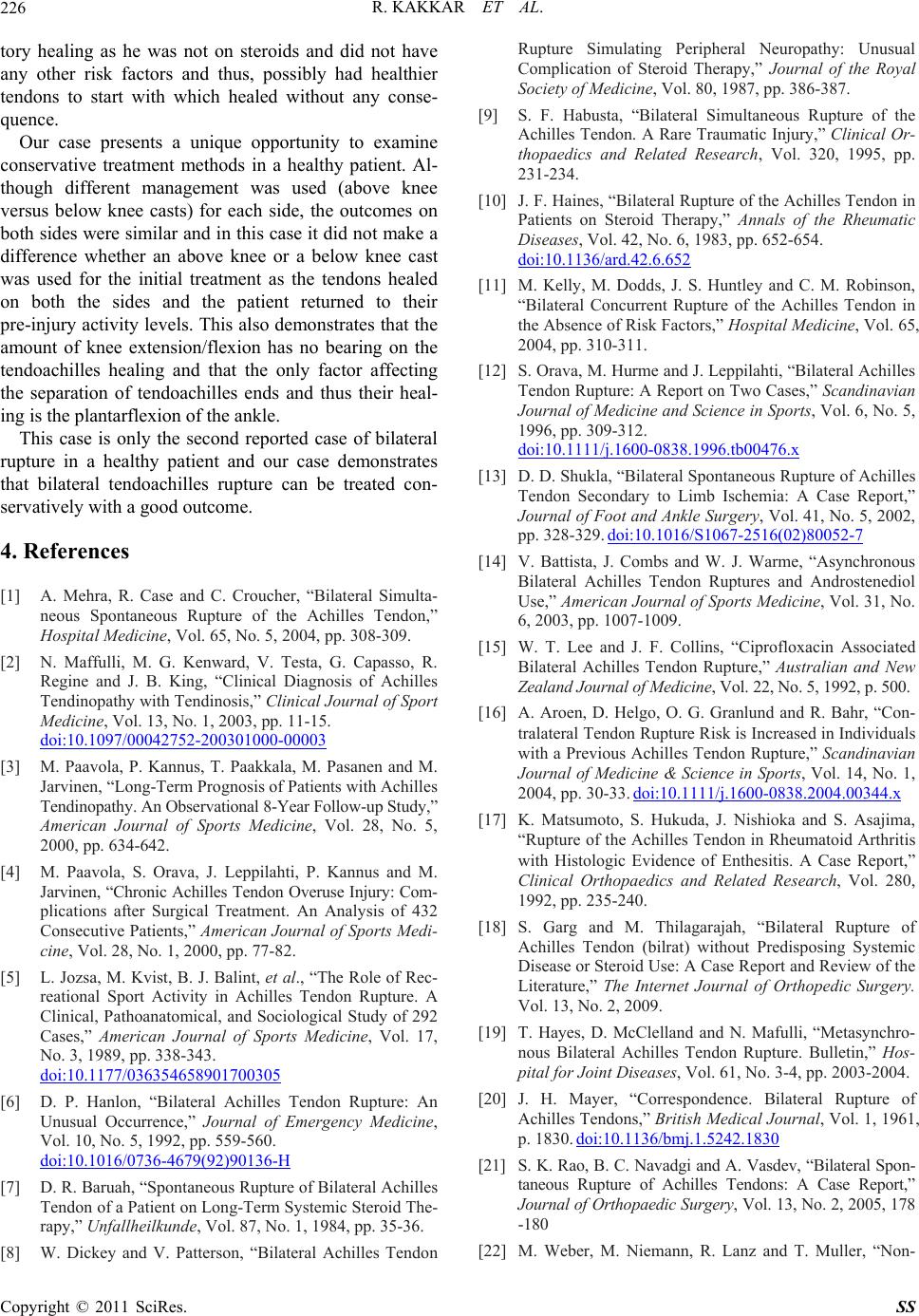
R. KAKKAR ET AL.
226
tory healing as he was not on steroids and did not have
any other risk factors and thus, possibly had healthier
tendons to start with which healed without any conse-
quence.
Our case presents a unique opportunity to examine
conservative treatment methods in a healthy patient. Al-
though different management was used (above knee
versus below knee casts) for each side, the outcomes on
both sides were similar and in this case it did not make a
difference whether an above knee or a below knee cast
was used for the initial treatment as the tendons healed
on both the sides and the patient returned to their
pre-injury activity levels. This also demonstrates that th e
amount of knee extension/flexion has no bearing on the
tendoachilles healing and that the only factor affecting
the separation of tendoachilles ends and thus their heal-
ing is the plantarflexion of the ankle.
This case is only the second reported case of bilateral
rupture in a healthy patient and our case demonstrates
that bilateral tendoachilles rupture can be treated con-
servatively with a good outcome.
4. References
[1] A. Mehra, R. Case and C. Croucher, “Bilateral Simulta-
neous Spontaneous Rupture of the Achilles Tendon,”
Hospital Medicine, Vol. 65, No. 5, 2004, pp. 308-309.
[2] N. Maffulli, M. G. Kenward, V. Testa, G. Capasso, R.
Regine and J. B. King, “Clinical Diagnosis of Achilles
Tendinopathy with Tendinosis,” Clinical Journal of Sport
Medicine, Vol. 13, No. 1, 2003, pp. 11-15.
doi:10.1097/00042752-200301000-00003
[3] M. Paavola, P. Kannus, T. Paakkala, M. Pasanen and M.
Jarvinen, “Long-Term Prognosis of Patients with Achilles
Tendinopathy. An Observational 8-Year Follow-up Study,”
American Journal of Sports Medicine, Vol. 28, No. 5,
2000, pp. 634-642.
[4] M. Paavola, S. Orava, J. Leppilahti, P. Kannus and M.
Jarvinen, “Chronic Achilles Tendon Overuse Injury: Com-
plications after Surgical Treatment. An Analysis of 432
Consecutive Patients,” American Journal of Sports Medi-
cine, Vol. 28, No. 1, 2000, pp. 77-82.
[5] L. Jozsa, M. Kvist, B. J. Balint, et al., “The Role of Rec-
reational Sport Activity in Achilles Tendon Rupture. A
Clinical, Pathoanatomical, and Sociological Study of 292
Cases,” American Journal of Sports Medicine, Vol. 17,
No. 3, 1989, pp. 338-343.
doi:10.1177/036354658901700305
[6] D. P. Hanlon, “Bilateral Achilles Tendon Rupture: An
Unusual Occurrence,” Journal of Emergency Medicine,
Vol. 10, No. 5, 1992, pp. 559-560.
doi:10.1016/0736-4679(92)90136-H
[7] D. R. Baruah, “Spontaneous Rupture of Bilateral Achilles
Tendon of a Patient on Long-Term Systemic Steroid The-
rapy,” Unfallheilkunde, Vol. 87, No. 1, 1984, pp. 35-36.
[8] W. Dickey and V. Patterson, “Bilateral Achilles Tendon
Rupture Simulating Peripheral Neuropathy: Unusual
Complication of Steroid Therapy,” Journal of the Royal
Society of Medicine, Vol. 80, 1987, pp. 386-387.
[9] S. F. Habusta, “Bilateral Simultaneous Rupture of the
Achilles Tendon. A Rare Traumatic Injury,” Clinical Or-
thopaedics and Related Research, Vol. 320, 1995, pp.
231-234.
[10] J. F. Haines, “Bilateral Rupture of the Achilles Tendon in
Patients on Steroid Therapy,” Annals of the Rheumatic
Diseases, Vol. 42, No. 6, 1983, pp. 652-654.
doi:10.1136/ard.42.6.652
[11] M. Kelly, M. Dodds, J. S. Huntley and C. M. Robinson,
“Bilateral Concurrent Rupture of the Achilles Tendon in
the Absence of Risk Factors,” Hospital Medicine, Vol. 65,
2004, pp. 310-311.
[12] S. Orava, M. Hurme and J. Leppilahti, “Bilateral Achilles
Tendon Rupture: A Report on Two Cases,” Scandinavian
Journal of Medicine and Science in Sports, Vol. 6, No. 5,
1996, pp. 309-312.
doi:10.1111/j.1600-0838.1996.tb00476.x
[13] D. D. Shukla, “Bilateral Spontaneous Rupture of Achilles
Tendon Secondary to Limb Ischemia: A Case Report,”
Journal of Foot and Ankle Surgery, Vol. 41, No. 5, 2002,
pp. 328-329. doi:10.1016/S1067-2516(02)80052-7
[14] V. Battista, J. Combs and W. J. Warme, “Asynchronous
Bilateral Achilles Tendon Ruptures and Androstenediol
Use,” American Journal of Sports Medicine, Vol. 31, No.
6, 2003, pp. 1007-1009.
[15] W. T. Lee and J. F. Collins, “Ciprofloxacin Associated
Bilateral Achilles Tendon Rupture,” Australian and New
Zealand Journal of Medicine, Vol. 22, No. 5, 1992, p. 500.
[16] A. Aroen, D. Helgo, O. G. Granlund and R. Bahr, “Con-
tralateral Tendon Rupture Risk is Increased in Individuals
with a Previous Achilles Tendon Rupture,” Scandinavian
Journal of Medicine & Science in Sports, Vol. 14, No. 1,
2004, pp. 30-33. doi:10.1111/j.1600-0838.2004.00344.x
[17] K. Matsumoto, S. Hukuda, J. Nishioka and S. Asajima,
“Rupture of the Achilles Tendon in Rheumatoid Arthritis
with Histologic Evidence of Enthesitis. A Case Report,”
Clinical Orthopaedics and Related Research, Vol. 280,
1992, pp. 235-240.
[18] S. Garg and M. Thilagarajah, “Bilateral Rupture of
Achilles Tendon (bilrat) without Predisposing Systemic
Disease or Steroid Use: A Case Report and Review of the
Literature,” The Internet Journal of Orthopedic Surgery.
Vol. 13, No. 2, 2009.
[19] T. Hayes, D. McClelland and N. Mafulli, “Metasynchro-
nous Bilateral Achilles Tendon Rupture. Bulletin,” Hos-
pital for Joint Diseases, Vol. 61, No. 3-4, pp. 2003-2004.
[20] J. H. Mayer, “Correspondence. Bilateral Rupture of
Achilles Tendons,” British Medical Journal, Vol. 1, 1961,
p. 1830. doi:10.1136/bmj.1.5242.1830
[21] S. K. Rao, B. C. Navadgi and A. Vasdev, “Bilateral Spon-
taneous Rupture of Achilles Tendons: A Case Report,”
Journal of Orthopaedic Surgery, Vol. 13, No. 2, 2005, 178
-180
[22] M. Weber, M. Niemann, R. Lanz and T. Muller, “Non-
Copyright © 2011 SciRes. SS